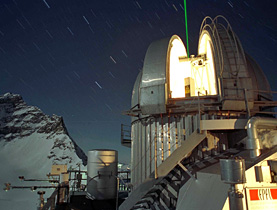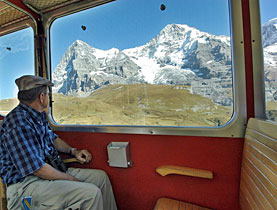Laser on Jungfraujoch gives CO2 clues

From the icy heights of the Bernese Alps, climatologists are using light in breakthrough ways to gather real-time data on how humans are affecting the environment.
At 3,471 metres on the Jungfraujoch, a saddle between the Mönch and Jungfrau summits, scientists have installed a Swiss-made laser device that can help determine the source of carbon dioxide (CO2), a main greenhouse gas.
Until now climatologists interested in tracking CO2 levels in high-alpine regions have had to rely on individual samples painstakingly gathered and tested in distance laboratories. Such experiments on the Jungfraujoch have until recently only afforded a seasonal-view of atmospheric changes.
The new instrument, which uses a quantum cascades laser produced by Neuchâtel-based Alpes Lasers, provides up-to-the-minute data on what’s happening in the troposphere, the lowest atmospheric layer, over Switzerland. Scientists hundreds of kilometres away in Zurich – or anywhere for that matter – can monitor the changes instantly.
“This is one of the puzzle elements that helps us understand the whole system better,” Lukas Emmenegger, a scientist involved with the project at the Laboratory for Air Pollution and Environmental Technologies, told swissinfo.
“This is a key element we can use to create models on greenhouse gas and eventually what we have to do about it.”
CO2 vs CO2
The heart of the instrument, which weighs about 100 kilograms and costs SFr150,000 ($125,000), features a laser that produces a beam of mid- to far-range infrared radiation. That is the exact frequency scientists can use to make precise CO2 measurements.
By pumping air regularly into a 500ml chamber ringed with mirrors, scientists can constantly assess what molecules are inside based on the way the laser reacts when it strikes them.
Carbon dioxide produced naturally, say by the ocean or when things rot, is slightly lighter than carbon dioxide produced by burning fossil fuels. The laser can tell the difference because the different weights produce different reflections, Emmenegger said.
“We can now look at individual packages of air reaching a specific place,” he said. “It will always be a mixture of carbon dioxide, but the measurements we have on a minute-by-minute scale will help us to understand regional, even global, CO2 cycles.”
Why the Jungfraujoch?
Emmenegger says scientists first installed the device on the Jungfraujoch about three months ago, which is still too soon to make any observations on the data collected so far.
“You must not imagine that the instrument is just sitting out in snow,” he said. “It’s one piece of the puzzle embedded in a large system of research.”
The broad, icy saddle is particularly well suited for making atmospheric observations since it is one of the highest regions in Switzerland easily accessible to monitors, in this case thanks to a train cut spectacularly through the mountains.
The air moving across the col at that altitude is valuable for scientists because it contains a wide-range of particles collected from across the continent, both from manmade and natural sources.
The site is already host to a pollution-monitoring station for the National Network for Monitoring Air Pollutants and a division of the World Meteorological Organization.
“Before, instruments like this one were quite large and you couldn’t really move them,” Emmenegger said. “We found a way to make it transportable and it works.”
swissinfo, Tim Neville
The Laboratory for Air Pollution and Environmental Technologies (Empa) is a group within the Swiss Federal Laboratories for Materials Testing and Research, which helped fund the project along with the Federal Environment Office and the National Centre of Competence in Research in Quantum Photonics.
Empa, based in Zurich, focuses research and development on the requirements of industry and society and ways science can enhance them.
Lukas Emmenegger has helped developed several spectroscopic instruments, such as the one being used on the Jungfraujoch, to produce rapid and highly precise measurements of greenhouse gases. The general aim of his research is to reduce manmade pollution based on a deep understanding of the cycles involved.
The largest greenhouse gas in the atmosphere is water vapour, which is responsible for as much as 70 per cent of the greenhouse effect. Carbon dioxide is the next largest contributor to that effect, followed by methane and ozone.

In compliance with the JTI standards
More: SWI swissinfo.ch certified by the Journalism Trust Initiative












You can find an overview of ongoing debates with our journalists here . Please join us!
If you want to start a conversation about a topic raised in this article or want to report factual errors, email us at english@swissinfo.ch.